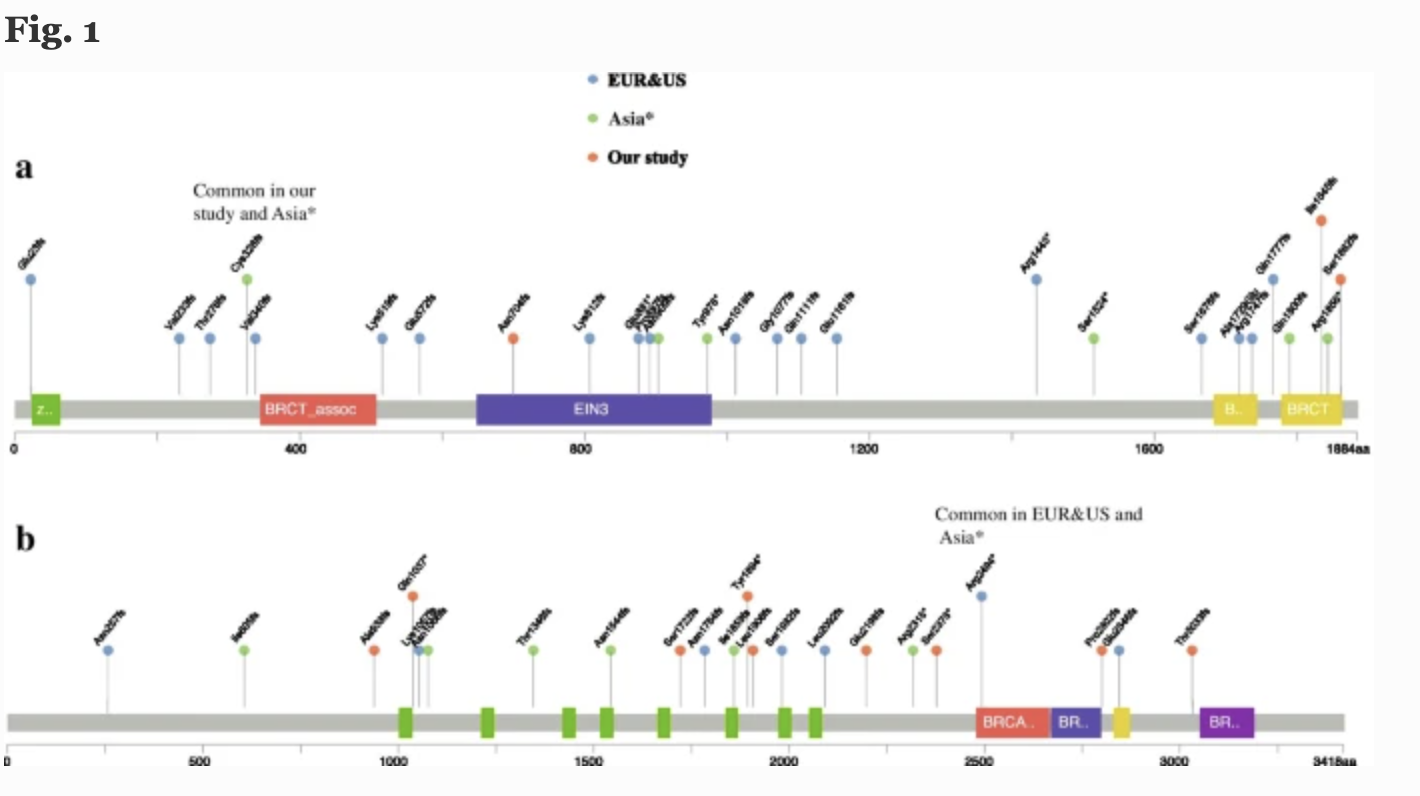注意到这个研究是因为自己也一直在看乳腺癌相关文献,2021年1月新鲜出炉的,标题是:《Prevalence and reclassification of BRCA1 and BRCA2 variants in a large, unselected Chinese Han breast cancer cohort》,链接是:https://link.springer.com/article/10.1186/s13045-020-01010-0
全文短小精悍,就是汇总一个课题结果,一个多中心队列:a Chinese multicenter cohort of 21,216 BC patients and 6434 healthy controls. 在这个队列做了 panel-based sequencing served to detect BRCA1/2 variants ,汇报一下结果,就是:pathogenic variants was 5.5% (1174/21,216) in BC patients and 1.1% (71/6434) in healthy controls.
当然了,仅仅是发现突变就太小儿科了,起码的注释和分类仍然是要弄的,重要的知识点是ClinVar database (clinvar_20171002.vcf.gz) and ACMG guidelines
- 532 (27.2%) variants are pathogenic,
- 858 (43.8%) are VUS,
- the remaining 568 variants (29.0%) are benign
这样全部筛查到的1958 BRAC1/2 variants 就有了意义。当然了,还可以深入到基因的外显子,功能结构域去讨论这些突变,比如: - Zinc/Ring finger (green);
- Serine cluster domain (blue);
- BRCT domain (red);
- BRCT (C terminus) (yellow).

让我们来看看,他为什么只有4个参考文献:
其中两个参考文献是中国人的类似的BRCA1/2 研究队列: - Germline mutations in cancer susceptibility genes in a large series of unselected breast cancer patients. Clin Cancer Res. 2017;
- Germline variation in BRCA1/2 is highly ethnic-specific: evidence from over 30,000 Chinese hereditary breast and ovarian cancer patients. Int J Cancer. 2019;
还有一个参考文献是韩国人队列: - The prevalence and spectrum of BRCA1 and BRCA2 mutations in Korean population: recent update of the Korean Hereditary Breast Cancer (KOHBRA) study. Breast Cancer Res Treat. 2015;
这些都是理所当然的, 甚至如果想把文章内容丰富一点,可以搜罗全世界各地的BRCA1/2 队列研究,欧美那边超级多。
不过,最后一篇参考文献就很有意思了,曾经一度刷爆朋友圈:Accurate classification of BRCA1 variants with saturation genome editing. Nature. 2018; 那,为什么引用它呢,我看了看,是We also re-analyzed the 100 variants in 13 exons (2–5 and 15–23) of the BRCA1 genes using a functional assay (saturation genome editing; SGE). - 55 of the 59 VUS had distinct status in the SGE study:
- 24 (43.6%) were pathogenic,
- 31 (56.4%) were benign.
但即使是他们使用了 saturation genome editing 这个方法,最后仍然是提出来了:there is a need to develop a classification system that categorizes the known variants into pathogenic, VUS, and benign in the Chinese population.
因为他们认为:The biological impact of variants in the literature, allele frequency in the Chinese patients, and the general Chinese population should be incorporated into this classification system.
最后,不得不说,医院科研合作确实是好事,尤其是这样的多个省市多个医院的大队列:During a period from 10-01-2015 to 12-15-2018, we collected 21,216 unselected Chinese BC patients and 6434 healthy controls in 19 medical centers in 11 Chinese provinces文末友情推荐
- 《2021生信学习班起航,先送福利》
- 《96核心384G内存的超级服务器(共享)使用权一年》